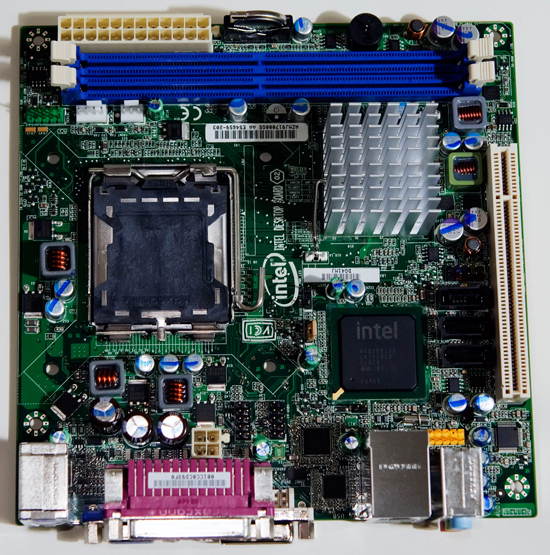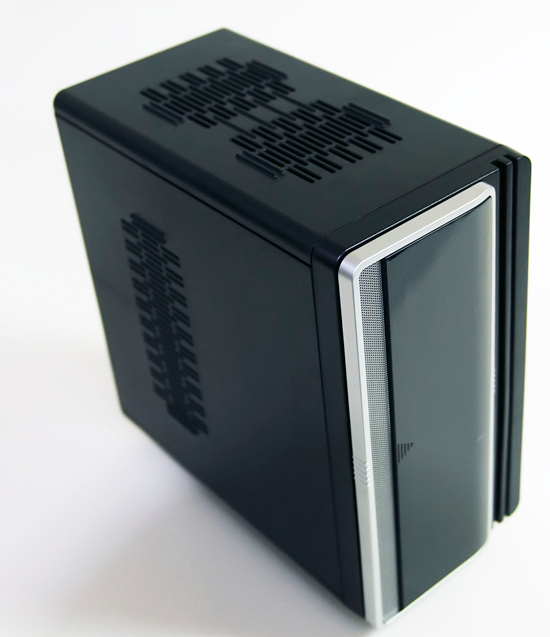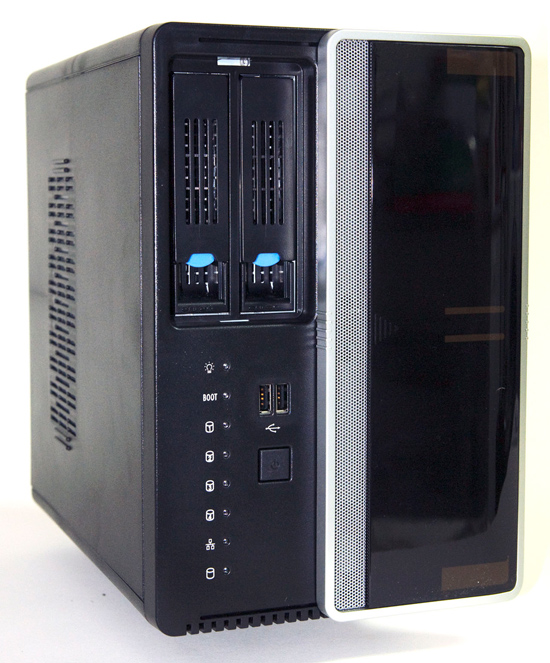Home Servers, Network Storage and the Case House
by Loyd Case on December 2, 2009 12:00 AM EST- Posted in
- Cases/Cooling/PSUs
The X Factor
All we really need around the house is reliable network access, the ReadyNAS would probably run forever – or at least, until it died. But I do like to play with new toys, and I’d been thinking about bringing up a Windows Home Server system for quite a few months.
Of course, you can just buy an off-the-shelf WHS system built by HP or a number of other companies, but that would be too easy. All the PCs in our house were built from the ground up, so I felt compelled to actually build a Windows Home Server system from scratch. Of course, I could have simply taken some of the old PC hardware around here and built up a server from spare parts. That had some attraction, since it would have been fairly inexpensive. It would also have been, in my mind, a somewhat inelegant solution. The smallest power supply I have here is 430W, and even micro ATX cases are bulkier than the ReadyNAS 600.
On the other hand, I’ve had this motherboard for a few months now.

This mini-ITX board is made by Intel, ostensibly for small office or media centric PCs. I never really found a use for it, as most of my applications typically require more graphics horsepower. The Intel DG41MJ board uses the Intel G41 chipset and accepts LGA 775 CPUs (up to 65W TDP.)
Then, one day, I was at my favorite local white box store (Central Computer, in San Jose, CA), and stumbled across this case.

At first, I thought it was just another of many small form factor, slimline cases, ostensibly designed as small Media Center PC cases. But it seemed slightly more bulky than the typical case of that type. The feature list also mentioned “two hot swappable SATA drive bays.” So I slid the front panel open and found that there were, indeed, a pair of hot swappable drive bays.

I checked out the specs and discovered that the Chenbro ES32067 is actually a mini-ITX server case. At roughly $120, it ships with a 150W PSU – smaller than the 220W PSU in the ReadyNAS 600. So I bought one.










87 Comments
View All Comments
nilepez - Thursday, December 3, 2009 - link
Bull. Give linux 100 normal PC users. Give another 100 WHS. One thing is certain: more will be successful with WHS than *nix.And to be clear, normal users don't work in IT (though I know plenty of people under that broad umbrella that couldn't set up either).
mcnabney - Thursday, December 3, 2009 - link
The backup features for Windows clients makes Home Server a no-brainer. I get full backup capability for seven Windows machines of various flavors without duplicating information since the same data is only stored once instead of for each backed-up system. Plus with the easy and secure remote access, loads of easy to use apps, automated backup, easy streaming, and selective data duplication - the choice is obvious. WHS is by far Microsoft's best work for a targeted need.piroroadkill - Thursday, December 3, 2009 - link
Vista and XP don't support software raid of the box, do they?jdjbuffalo - Thursday, December 3, 2009 - link
Yes they do support software RAID.HanSolo71 - Wednesday, December 2, 2009 - link
Smaller then my rig by a long shot, for my NAS i use a IBM Xseries 225, and its over 26" long, although i do have only 3 drives in it that soon will be 7, with 6 being 1.5TB drives in RAID 5mcnabney - Thursday, December 3, 2009 - link
Hah!My Home Server laughs at your puny rig.
An old Armour+ case - free
Low power AthlonX2 chip on an microATX MB ~$100
1GB of DDR2 left sitting around - free
extra SATA controller ~$30
550W Corsair PS ~ $60
Connectors/cables from Monoprice ~ $20
Extra fans and cages ~ $35
TWELVE 1.5TB seagate drive ~ $83 each (thanks Dell!) = $990
WHS OEM license ~ $85
So $1320 provided 18TB of storage
Why yes, I do stream media to all seven PCs in my home. At the same time without a hitch. And my laptops over the Internet. And store tens of thousands of pictures. And all of my movies. Plus all of the home movies. For my entire extended family. Oh, and I store offsite bare drives for backup purposes so I only use folder duplication for data that has not been copied offsite.
RAID =/ backup or security and I don't care about 'up-time'
The box can already saturate gigabit ethernet
Never had a drive fail in the past 18 months... yet.
Server has only shut down to install updates - never crashed
And it only sucks ~50 watts out of the wall when actually doing something
Inglix - Sunday, December 6, 2009 - link
50w? Really? I mean the all the drives spun up would take 100w with a 100% efficient power supply. I know that's not a typical situation but at idle WHS isn't the best at leaving them alone. Even with just one spun up disk that would be difficult with a 550w psu...I do congratulate you on keeping offsite backups and not thinking WHS duplication is good enough though!
3DoubleD - Friday, December 4, 2009 - link
12 * 1.5 TB = 18 TB... you can't have 18 TB of storage if you hope to backup any data. I'm sorry, but you have far less storage than you admit/realize. If you duplicate every file you only have 9 TB of storage. You mentioned you don't duplicate everything, but you will always have far less than 18 TB storage unless you backup none of your data.Unraid is the ultimate NAS storage. If you are tech savvy enough to be reading this article, you can handle Unraid. It is a striped down version of Slackware with added functionality for data parity and easy networking. You have one parity drive that is the size of your largest disk in your array. You can have up to 16 disks in you array. So in the case of "Mr. Home Server laughs at your puny rig" he would have 1 1.5TB parity drive and 11 1.5TB data drives for a total storage space of 16.5TB, all completely parity protected. If a drive fails, go buy a new 1.5TB hdd, add it to the array, and the disk is rebuilt from parity.
Data can be allocated to the drive by user shares. You can assign shares such as "Movies", "Pictures", "Documents", "Backups", ect. Each share can be added to Windows as a network drive. You can assign specific rules for data allocation in each share to the drives in your array (eg. keep data on one drive, fill one drive at a time, keep the same amount of free space on each drive in the array,ect.). All setup is done via browser user interface (it's really easy).
As with all parity protection systems, this doesn't protect against user error (data deletion). It also doesn't allow for multiple drive failures, but it allows you to recover the data from the remaining drives as they are in a linux friendly file format. However, it offers a superior way to maintain a NAS that parity protects your data in addition to being easily expandable (need more space? Just add a drive to the array). If you want to include bigger drives, you just replace the parity drive with a bigger drive, rebuilt the parity, and then add the old parity drive to the array. From then on you can incorporate the size of the new parity drive into your array. It is the poor man's RAID server. I've had one for nearly a year and I can't imagine my network without it.
WHS is great if you have no idea what you are doing, but much better options exist.
kkwst2 - Sunday, December 6, 2009 - link
Holy Crap, just what wanted to hear, one more troll who has clearly never spent any time with WHS go on about how you can do so much more with a NAS unit.The author of the article clearly has used NAS extensively. I've used NAS extensively. Beyond being easier to maintain, WHS allows you to do things you simply cannot do with NAS. I've no need to regurgitate it here, either read up on it or go away.
If you think 1 out of 12 drives for a parity drive gives you data protection then you are a fool. With that many drives, the likelihood of 2 drive failures is certainly not insignificant.
To recap: 1) I know what I'm doing, and WHS is still the best option for my home. 2) I would stop giving out advice, when your concept of data security is very flawed. 3) Read more, rant less.
3DoubleD - Tuesday, December 8, 2009 - link
Dude, if two of your drives failed simultaneously you would lose data too. The same is true with a RAID, except you lose all of your data. WHS and Unraid both can sustain multiple drive failures and only lose some data. The chances of a two drive failure is low (ridiculously tiny). If you have multiple drives failing it's probably a power supply failure and you are screwed anyway. Or maybe it's because you are not so smart and bought 12 of the same drive at the same time (all from the same production line). I never buy two drives at the same time. I buy them as I need it which saves me money and lowers my risk for multiple drive failures. Finally, if you have super important data, you should have another backup, just in case. The bottom line - Unraid gives you the same data security for way less investment and storage space. I hope you enjoyed my "rant" and good luck with wasting almost half your storage space.